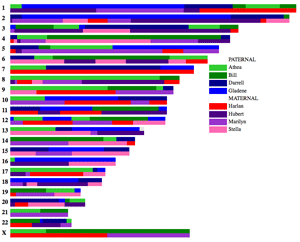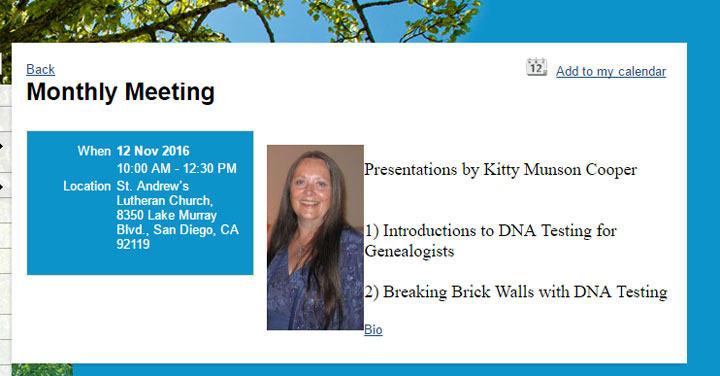The Genealogy Society of San Diego is having me give two talks this coming Saturday, one about DNA basics for genealogists and the other about how I broke some brick walls with DNA testing in my own family.
Talking about using DNA for genealogy is something I love to do. While I have lots of posts and pages here, there is nothing like being able to discuss it in person. The questions I get teach me what is difficult to grasp about this shiny new tool in our genealogy kit so that I can better help others.
After the talk, I will put the links to my slides at the end of this article, but they have very few words so they are less useful if you were not there. All my presentation slides are at slides.com/kittycooper and the handouts that go with them are in my downloads area here.
If you cannot make it Saturday, here are a few of my articles on DNA basics, all of which are listed under the DNA testing tab in the top menu above:
- DNA basics – http://blog.kittycooper.com/dna-testing/dna-basics/
- Where to Test – http://blog.kittycooper.com/dna-testing/
- Using your DNA test for Genealogy – http://blog.kittycooper.com/2015/03/using-your-dna-test-results-the-basics-for-genealogists/
- And the DNA Newbie FAQ – http://blog.kittycooper.com/dna-testing/newbie-faq/
Many people test their DNA because they want to know their deeper roots, Viking or Saxon or Italian? Native American or Asian? Any Jewish? Any African? Each of these ancestries has signatures that can be seen in your DNA but the art of telling them apart is in its infancy and varies widely from company to company. Click here for my blog post showing my brother’s ancestry as determined by each one.
A more reliable way to look at deep ancestry is to analyze your Y chromosome and your mitochondrial DNA (mtDNA). Since these do not recombine, they change very slowly (via mutations only), and can be grouped into “haplogroups.” These can then be looked up at wikipedia or eupedia to learn more about where they originated. Of course these come from a very small subset of your ancestors – the Y from the all male (father’s father’s father, etc) line and the mtDNA from the all female (mother’s mother’s mother, etc) line.
My Dad is an R1b, the most common Y haplogroup in Western Europe, likely to have been spread by the Indo-European invasion of Europe with its superior technology of bronze weapons and horse drawn chariots … The Eupedia article on this haplogroup is particularly good – http://www.eupedia.com/europe/Haplogroup_R1b_Y-DNA.shtml and has some pretty maps.
 However autosomal DNA is the star for testing recent lines on your family tree. Because the DNA on your 22 pairs of autosomes (the term for chromosomes that are not the XX or XY) comes from ALL your ancestors it is very accurate for predicting close family. However once you get more generations away it becomes more and more random. You will always share significant amounts of DNA with close family and first or second cousins, but 10% of the time you will not match a third cousin and 50% of the time you will not match a fourth cousin (see http://isogg.org/wiki/Cousin_statistics). Personally I share DNA with quite a few 5th cousins and even a few 8th and 9th cousins!
However autosomal DNA is the star for testing recent lines on your family tree. Because the DNA on your 22 pairs of autosomes (the term for chromosomes that are not the XX or XY) comes from ALL your ancestors it is very accurate for predicting close family. However once you get more generations away it becomes more and more random. You will always share significant amounts of DNA with close family and first or second cousins, but 10% of the time you will not match a third cousin and 50% of the time you will not match a fourth cousin (see http://isogg.org/wiki/Cousin_statistics). Personally I share DNA with quite a few 5th cousins and even a few 8th and 9th cousins!
This means that you can use autosomal DNA testing to confirm family lines. One of my favorite stories is that I was approached by a fellow genealogist who asked me if we could use DNA to confirm that his wife’s great-great-grandfather was the brother of my great-grandmother when the paper trail hinted at that but could not confirm it. I use this story in my more advanced talk on Triangulation, – http://blog.kittycooper.com/2015/02/triangulation-proving-a-common-ancestor/
The exciting thing for genealogists is using DNA matching to confirm family lines. There is a bit of a learning curve involved. My advice is to start with matches that are listed as 2nd or 3rd cousins by your testing company. Work on finding the common ancestor with them. Next work with people with whom you have more than one matching segment and at least one segment that is more than ten centimorgans (cMs) in size. Be sure to upload your test results to GEDmatch.com, DNA.land, and MyHeritage.com for even more matches.
Obviously DNA can also help adoptees find their biological families. The web site DNAadoption.com is dedicated to that task.
The more relatives you can talk into testing the more data you will have to work with. A word of warning, remind them that any family secrets might come out as a result and respect their choice to test or not to test. And if you find a surprise, be sure to be more sensitive than the cousin of Bill Griffeth was!
UPDATE: The slides for my first talk from today are now posted at http://slides.com/kittycooper/dna-basics#/ and the breaking brick walls talk is at http://slides.com/kittycooper/breaking-brick-walls-with-dna#/
Also I updated the slide that compares the three main companies and put the word file for it in my downloads area.Download

Have you run into anyone who has done work with allogenic stem cell transplant patients? These are people whose bone marrow cells have been replaced by a donor’s cells. In many cases the donor is a close relative. I am dealing with a case where the donor was the brother of the patient and am interested in any insights from others on what saliva DNA is likely to look like (in a successful transplant, blood DNA will definitely be the donor’s DNA).
George, I am going to post your question on the Rootsweb DNA mailing list where Dr Tim Janzen or Dr ANn Turner may be able to answer this. Else call the help desk (or email) at one of the companies. Ancestry and 23andme do saliva so less likely to be contaminated with blood. Family tree DNA does cheek scrapings.
George – I got quite a few responses and basically the consensus is yes this is a problem because saliva contains so many white blood cells. Test the brother instead.
A reference to this blog post was made:
http://blog.dnagenotek.com/blogdnagenotekcom/bid/35944/Rinse-Swab-or-Spit-What-s-the-Real-Source-of-DNA-in-Saliva
My question and the answers will eventually show up in the archives http://archiver.rootsweb.ancestry.com/th/index/GENEALOGY-DNA/2016-11 (not there yet)